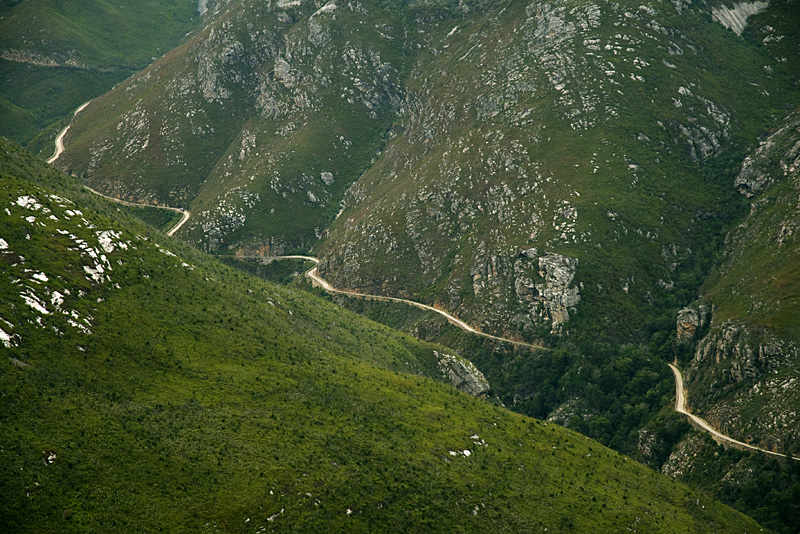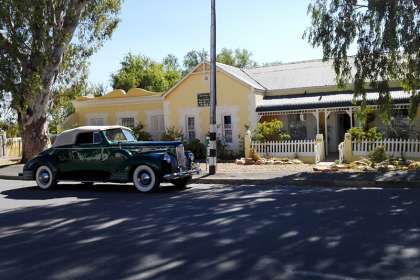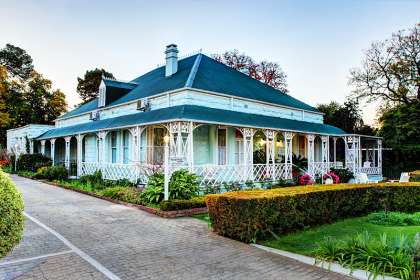Swartberg Pass - nr Prince Albert, Western Cape
Swartberg Pass - nr Prince Albert, Western Cape
The brilliant engineer and road builder, Thomas Charles Bain (1830 - 1893), built seventeen mountain passes in the Cape Province. The Swartberg Pass is one of the most spectacular and well known mountain passes in South Africa, linking Prince Albert and Oudtshoorn. The pass was declared a National Monument in 1988, 100 years after it was opened on the 10th January 1888.
The project began in 1879 when Thomas Bain was commissioned to plan a new route over the Swartberg Mountain Range due to the fact that the existing routes between the port of Mossel Bay and the towns and villages of the Great Karoo were often closed due to flood damage and rock falls. The footpath which already existed over the mountain between Prince Albert and Oudtshoorn was only suitable to be travelled either on foot or on horseback. Planning the route was a tough task due to the unavoidably steep gradients. The engineer tried four different lines before he succeeded in finding a practical one. Bain's plans for Swartberg Pass were approved by the Government in 1880.
John Tassie started building the pass from Prince Albert in 1881 with 100 Mozambican labourers from Delagoa Bay, but he was declared insolvent after building only 6km of the pass. Bain took over the building of the pass in November 1883 and used between 200 and 240 convicts to tackle the task. What people need to remember when looking at the feat, is that there was no heavy machinery involved, the pass was built using of pickaxes, spades, sledgehammers, crowbars, wheelbarrows and gunpowder. The giant boulders were split by heating them with fire and then dousing them with cold water. Rocks were broken into smaller pieces with sledgehammers and then carefully dressed by the convicts. And the dry-wall method of construction that was used to build the impressive retaining walls that held the road up against the mountain slopes is still holding it up a century later. The convicts were divided into teams and the ruins and remains of the convict stations can still be seen in the Swartberg Pass. It is said that Bain finished ahead of schedule and under-budget, a task which is unheard of especially in this day and age.
The Swartberg Pass was officially opened on 10th January 1888 and was a major event in the history of the town of Prince Albert. The opening saw the town of Prince Albert come to a standstill as every store was closed for the festivities. A procession left the town at 7am that day, on a 3 hour journey to the summit 1 585m above sea level. The procession included almost 500 people and 100 vehicles which were made up of spiders, capecarts and mule wagons. The pass was officially opened by Colonel F.X Schermbrucker who was the Commissioner of Crown Lands and Public Works and a twenty-one gun salute concluded the ceremony.
Over the years there has never been a need to tar this masterpiece the locals believe that this would actually ruin its beauty and its value as a national monument. A trip over the Swartberg Pass is an unforgettable experience for any visitor, whether local or foreign.
5 Interesting facts about the Swartberg Pass:
1. Engineering Marvel: The Swartberg Pass is considered one of the finest examples of road engineering in Southern Africa. It was built by Thomas Bain, a renowned road engineer, and completed in 1888. Bain and his team used dynamite to blast through the mountains, and much of the work was done by hand, creating a winding road with sharp curves and steep gradients.
2. Historical Significance: The pass has a rich history and was a crucial route for early settlers and farmers transporting goods between the Little Karoo and the Great Karoo. It facilitated trade and communication between the regions, playing a significant role in the development of the area.
3. Natural Beauty: The Swartberg Pass offers breathtaking views and showcases the dramatic scenery of the Swartberg Mountains. The pass cuts through rugged landscapes, offering panoramic vistas of deep gorges, towering cliffs, and unique rock formations. It is part of the Swartberg Nature Reserve, a UNESCO World Heritage Site, known for its biodiversity and geological importance.
4. Geological Wonder: The pass is a geological marvel, displaying a variety of rock formations and layers that date back hundreds of millions of years. The exposed rock strata reveal the ancient geological history of the region, making it a popular spot for geologists and enthusiasts interested in earth sciences.
5. Adventure Destination: The Swartberg Pass is a favorite destination for adventure seekers. It is a popular route for 4x4 enthusiasts, cyclists, and hikers who want to explore the rugged terrain and enjoy the challenging yet rewarding journey. The pass also provides access to several hiking trails and historical landmarks, including the ruins of old settlements and rock art sites.
The Swartberg Pass remains a testament to human ingenuity and natural beauty, attracting visitors from around the world who come to experience its unique blend of history, engineering, and stunning landscapes.
Accommodation Near Swartberg Pass - nr Prince Albert, Western Cape
Saxe-Coburg Lodge
Bed & Breakfast Accommodation in Prince Albert
12.7km from Swartberg Pass - nr Prince Albert, Western CapeSaxe-Coburg Lodge offers bed and breakfast accommodation in Prince Albert in the Klein Karoo and Groot Karoo region in the Western Cape. Nestling in Prince Albert, possibly the prettiest small town in South Africa, with its Karoo style, Cape Dutch and... …see more for bookings / enquiries and info.
Karoo View Cottages
Self Catering House, Cottage, Chalet Accommodation in Prince Albert
13.2km from Swartberg Pass - nr Prince Albert, Western CapeKaroo View Cottages offer self catering accommodation in Prince Albert in the Klein & Groot Karoo region in the Western Cape. We offer 7 cottage units and can accommodate up to 30 people. Units range from a 2 sleeper to an 8 sleeper. Our luxurious self-ca …see more for bookings / enquiries and info.
Wilgewandel Holiday Farm
Self Catering Apartment, Flatlet Accommodation in Oudtshoorn
18.1km from Swartberg Pass - nr Prince Albert, Western CapeWilgewandel Holiday Farm, the getaway to the largest showcase in Africa awaits your highly valued presence, this place of excitement and fun activities will offer you and your family appealing and aesthetically beautiful surroundings which will satisfy... …see more for bookings / enquiries and info.
Old Mill Lodge & A la carte Restaurant
Self Catering House, Cottage, Chalet Accommodation in Oudtshoorn
23.5km from Swartberg Pass - nr Prince Albert, Western CapeLuxury riverfront tent & luxury waterfront Cabin accommodation as well as omfortable and affordable bed and breakfast 4 star accommodation, Oudtshoorn. Accommodation near the Cango Caves, Schoemanshoek, only 12 km from us. We offer Family, normal and self …see more for bookings / enquiries and info.
The Retreat at Groenfontein
Bed & Breakfast Accommodation in Calitzdorp District
27.1km from Swartberg Pass - nr Prince Albert, Western CapeThe Retreat at Groenfontein offers bed and breakfast accommodation in the Calitzdorp District in the Klein & Groot Karoo region in the Western Cape. The Retreat is an old Victorian farmhouse set in 560ha of the Groenfontein Valley Conservancy bordering on …see more for bookings / enquiries and info.
Adley House
Self Catering Apartment, Flatlet Accommodation in Oudtshoorn
28.2km from Swartberg Pass - nr Prince Albert, Western CapeAdley House offers bed and breakfast and self catering accommodation in Oudtshoorn, Karoo, Western Cape. With modern amenities, relax in our well kept gardens and pools, park in safety ,in house on our large property. 14 large en-suite individually... …see more for bookings / enquiries and info.
 The Swartberg Pass was built using convict labour and opened on 10 January 1888 ©
The Swartberg Pass was built using convict labour and opened on 10 January 1888 ©  Snow on the Swartberg Mountains near Klaarstroom. ©
Snow on the Swartberg Mountains near Klaarstroom. ©  Spectacular views of the the vast Olifants River Valley and Swartberg Mountains, Oudtshoorn, Karoo. ©
Spectacular views of the the vast Olifants River Valley and Swartberg Mountains, Oudtshoorn, Karoo. ©  Views, views, views! From the top of the Swartberg Pass, near Prince Albert, Karoo. ©
Views, views, views! From the top of the Swartberg Pass, near Prince Albert, Karoo. ©  Swartberg (black mountain) Pass , south of Prince Albert. It was built using convict labour, and opened on 10 January 1888. The dry-stone retaining walls, supporting some of its hairpin bends, are still in place and almost 120 years old. ©
Swartberg (black mountain) Pass , south of Prince Albert. It was built using convict labour, and opened on 10 January 1888. The dry-stone retaining walls, supporting some of its hairpin bends, are still in place and almost 120 years old. © 






